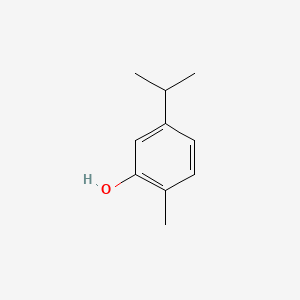| MeSH term | MeSH ID | Detail |
|---|---|---|
| Weight Gain | D015430 | 101 associated lipids |
| Hypercholesterolemia | D006937 | 91 associated lipids |
| Cross Infection | D003428 | 9 associated lipids |
| Brain Ischemia | D002545 | 89 associated lipids |
| Periodontitis | D010518 | 22 associated lipids |
| Poultry Diseases | D011201 | 21 associated lipids |
| Synovitis | D013585 | 15 associated lipids |
| Candidiasis, Vulvovaginal | D002181 | 8 associated lipids |
Carvacrol
Carvacrol is a lipid of Prenol Lipids (PR) class. Carvacrol is associated with abnormalities such as Consumption-archaic term for TB, Disintegration (morphologic abnormality), Infection, Corn of toe and Candidiasis of vagina. The involved functions are known as Stereochemistry, Anabolism, Oxidation, Process and Binding (Molecular Function). Carvacrol often locates in Skin, Nerve Tissue, Membrane, Endothelium and Plasma membrane. The associated genes with Carvacrol are P4HTM gene, TRPV3 gene, TRPV1 gene, TRPV2 gene and TRPV4 gene. The related lipids are Fatty Acids, Lipopolysaccharides, Octanols, Micelles and butyrate.
Cross Reference
Introduction
To understand associated biological information of Carvacrol, we collected biological information of abnormalities, associated pathways, cellular/molecular locations, biological functions, related genes/proteins, lipids and common seen animal/experimental models with organized paragraphs from literatures.
What diseases are associated with Carvacrol?
Carvacrol is suspected in Candidiasis of vagina, Infection, Infestation, Acquired partial lipodystrophy, Urticaria, Periodontitis and other diseases in descending order of the highest number of associated sentences.
Related references are mostly published in these journals:
| Disease | Cross reference | Weighted score | Related literature |
|---|
Possible diseases from mapped MeSH terms on references
We collected disease MeSH terms mapped to the references associated with Carvacrol
PubChem Associated disorders and diseases
What pathways are associated with Carvacrol
There are no associated biomedical information in the current reference collection.
PubChem Biomolecular Interactions and Pathways
Link to PubChem Biomolecular Interactions and PathwaysWhat cellular locations are associated with Carvacrol?
Visualization in cellular structure
Associated locations are in red color. Not associated locations are in black.
Related references are published most in these journals:
| Location | Cross reference | Weighted score | Related literatures |
|---|
What functions are associated with Carvacrol?
Related references are published most in these journals:
| Function | Cross reference | Weighted score | Related literatures |
|---|
What lipids are associated with Carvacrol?
Related references are published most in these journals:
| Lipid concept | Cross reference | Weighted score | Related literatures |
|---|
What genes are associated with Carvacrol?
Related references are published most in these journals:
| Gene | Cross reference | Weighted score | Related literatures |
|---|
What common seen animal models are associated with Carvacrol?
There are no associated biomedical information in the current reference collection.
NCBI Entrez Crosslinks
All references with Carvacrol
Download all related citations| Authors | Title | Published | Journal | PubMed Link |
|---|---|---|---|---|
| Cui ZW et al. | Carvacrol protects neuroblastoma SH-SY5Y cells against Fe(2+)-induced apoptosis by suppressing activation of MAPK/JNK-NF-κB signaling pathway. | 2015 | Acta Pharmacol. Sin. | pmid:26592517 |
| Kim JH et al. | Augmenting the Activity of Monoterpenoid Phenols against Fungal Pathogens Using 2-Hydroxy-4-methoxybenzaldehyde that Target Cell Wall Integrity. | 2015 | Int J Mol Sci | pmid:26569223 |
| Guevara L et al. | Impact of Moderate Heat, Carvacrol, and Thymol Treatments on the Viability, Injury, and Stress Response of Listeria monocytogenes. | 2015 | Biomed Res Int | pmid:26539510 |
| Feketa VV and Marrelli SP | Systemic Administration of the TRPV3 Ion Channel Agonist Carvacrol Induces Hypothermia in Conscious Rodents. | 2015 | PLoS ONE | pmid:26528923 |
| Novato TP et al. | Evaluation of the combined effect of thymol, carvacrol and (E)-cinnamaldehyde on Amblyomma sculptum (Acari: Ixodidae) and Dermacentor nitens (Acari: Ixodidae) larvae. | 2015 | Vet. Parasitol. | pmid:26346899 |
| Ahmed HH et al. | Implications of Sex Hormone Receptor Gene Expression in the Predominance of Hepatocellular Carcinoma in Males: Role of Natural Products. | 2015 | Asian Pac. J. Cancer Prev. | pmid:26163620 |
| Patricelli D et al. | Plant defences against ants provide a pathway to social parasitism in butterflies. | 2015 | Proc. Biol. Sci. | pmid:26156773 |
| Peng G et al. | Plant-Derived Tick Repellents Activate the Honey Bee Ectoparasitic Mite TRPA1. | 2015 | Cell Rep | pmid:26146083 |
| Pires PW et al. | Unitary TRPV3 channel Ca2+ influx events elicit endothelium-dependent dilation of cerebral parenchymal arterioles. | 2015 | Am. J. Physiol. Heart Circ. Physiol. | pmid:26453324 |
| Andrade-Ochoa S et al. | Quantitative structure-activity relationship of molecules constituent of different essential oils with antimycobacterial activity against Mycobacterium tuberculosis and Mycobacterium bovis. | 2015 | BMC Complement Altern Med | pmid:26400221 |
